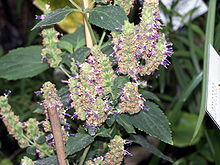Rhamnetine
| Structural formula | |||||||||||||||||||
|---|---|---|---|---|---|---|---|---|---|---|---|---|---|---|---|---|---|---|---|

|
|||||||||||||||||||
| General | |||||||||||||||||||
| Surname | Rhamnetine | ||||||||||||||||||
| other names |
|
||||||||||||||||||
| Molecular formula | C 16 H 12 O 7 | ||||||||||||||||||
| Brief description |
light yellow powder |
||||||||||||||||||
| External identifiers / databases | |||||||||||||||||||
|
|||||||||||||||||||
| properties | |||||||||||||||||||
| Molar mass | 316.26 g mol −1 | ||||||||||||||||||
| Physical state |
firmly |
||||||||||||||||||
| Melting point |
288-290 ° C |
||||||||||||||||||
| solubility |
|
||||||||||||||||||
| safety instructions | |||||||||||||||||||
|
|||||||||||||||||||
| As far as possible and customary, SI units are used. Unless otherwise noted, the data given apply to standard conditions . | |||||||||||||||||||
Rhamnetin is a chemical compound from the group of flavonoids or flavonols and is isomeric to isorhamnetin .
Occurrence
Rhamnetin occurs naturally in Indian patchouli and as the main pigment in buckthorn berries (Latin rhamnus , hence the name) and a few other plants. It is produced by the hydrolysis of xanthorhamnine . It was first examined by Liebermann, Hörmann and Josef Herzig in the 1880s .
Extraction and presentation
Rhamnetin can be produced artificially by enzymatic means using O- methyltransferase-7.
properties
Rhamnetin is a light yellow odorless powder. It is a monomethyl ether of quercetin .
use
Rhamnetin is used in paper finishing as part of the developer layer in pressure-sensitive copier papers.
Individual evidence
- ↑ a b c d e Rhamnetin data sheet at Sigma-Aldrich , accessed on May 21, 2017 ( PDF ).
- ↑ Zhou, Jiaju; Xie, Guirong; Yan, Xinjian: Encyclopedia of Traditional Chinese Medicines Vol 4 - Molecular Structures, Pharmacological Activities, Natural Sources and Applications . Springer Berlin, 2011, ISBN 978-3-642-16778-2 , pp. 400 ( limited preview in Google Book Search).
- ↑ a b drug future: Rhamnetin
- ↑ Sabine Struckmeier: Textile dyeing from the late Middle Ages to the early modern period . Waxmann, 2011, ISBN 978-3-8309-2527-9 , pp. 127 ( limited preview in Google Book search).
- ^ Gerhard G. Habermehl, Peter E. Hammann, Hans C. Krebs, W. Ternes: Naturstoffchemie: An introduction . Springer Berlin, 2008, ISBN 978-3-540-73732-2 , pp. 481 ( limited preview in Google Book search).
- ↑ Bruce A. Bohm, Tod F. Stuessy: Flavonoids of the Sunflower Family (Asteraceae) . Springer, Vienna, 2001, ISBN 978-3-211-83479-4 , pp. 779 ( limited preview in Google Book search).
- ↑ synthesis of rhamnetin and Rhamnazin, Richard Kuhn, Irmentraut Loew, Journal of the American Chemical Society (A and B Series), Volume 77, Issue 3-4, pages 211-218, April 26, 1944 , doi : 10.1002 / cber.19440770313
- ↑ J. Herzig: About Rhamnin and Rhamnetin . In: Monatshefte für Chemie / Chemical Monthly, Volume 6, Number 1 (1885), pp. 889-890, doi : 10.1007 / BF01554674 .
- ↑ Sunhee Leea, Soon Young Shinb, Younggiu Leea, Younghee Parka, Bong Gyu Kima, Joong-Hoon Ahna, Youhoon Chonga: Rhamnetin production based on the rational design of the poplar O-methyltransferase enzyme and its biological activities Bioorganic & Medicinal Chemistry Letters, 21 (2011) 3866-3870, doi : 10.1016 / j.bmcl.2011.05.043 .
- ↑ Werner Baumann, Herberg-Liedtke: Paper chemicals: data and facts on environmental protection . Springer Berlin, 1993, ISBN 978-3-540-57593-1 , pp. 621 ( limited preview in Google Book search).

